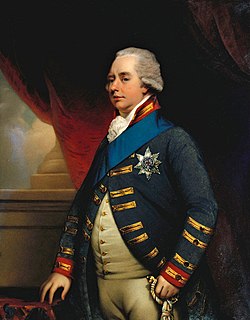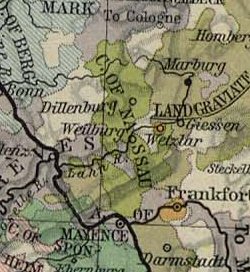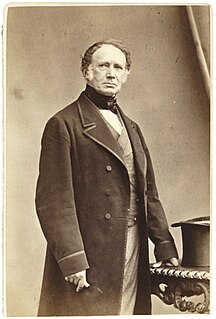
William I was a Prince of Orange, the King of the Netherlands and Grand Duke of Luxembourg.

The United Kingdom of the Netherlands is the unofficial name given to the Kingdom of the Netherlands as it existed between 1815 and 1839. The United Netherlands was created in the aftermath of the Napoleonic Wars through the fusion of territories that had belonged to the former Dutch Republic, Austrian Netherlands, and Prince-Bishopric of Liège in order to form a buffer state between the major European powers. The polity was a constitutional monarchy, ruled by William I of the House of Orange-Nassau.

The House of Orange-Nassau is the current reigning house of the Netherlands. A branch of the European House of Nassau, the house has played a central role in the politics and government of the Netherlands and Europe especially since William the Silent organised the Dutch Revolt against Spanish rule, which after the Eighty Years' War (1568–1648) led to an independent Dutch state.

William V was a prince of Orange and the last stadtholder of the Dutch Republic. He went into exile to London in 1795. He was furthermore ruler of the Principality of Orange-Nassau until his death in 1806. In that capacity he was succeeded by his son William.

The County of Nassau was a German state within the Holy Roman Empire and later part of the German Confederation. Its ruling dynasty, the male line of which is now extinct, was the House of Nassau.

Prince of Orange is a title originally associated with the sovereign Principality of Orange, in what is now southern France and subsequently held by sovereigns in the Netherlands.

Huis ten Bosch is a royal palace in The Hague, Netherlands. It is one of three official residences of the Dutch monarch; the two others being the Noordeinde Palace in The Hague and the Royal Palace in Amsterdam.

The County of Isenburg was a region of Germany located in southern present-day Hesse, located in territories north and south of Frankfurt. The states of Isenburg emerged from the Niederlahngau, which partitioned in 1137 into Isenburg-Isenburg and Isenburg-Limburg-Covern. These countships were partitioned between themselves many times over the next 700 years.

The Princely Abbey of Corvey is a former Benedictine abbey and ecclesiastical principality now in North Rhine-Westphalia, Germany. It was one of the half-dozen self-ruling princely abbeys of the Holy Roman Empire from the late Middle Ages until 1792 when Corvey was elevated to a prince-bishopric. Corvey, whose territory extended over a vast area, was in turn secularized in 1803 in the course of the German mediatisation and absorbed into the newly created Principality of Nassau-Orange-Fulda. Originally built in 822 and 885 and remodeled in the Baroque period, the abbey is an exceptional example of Carolingian architecture, the oldest surviving example of a westwork, and the oldest standing medieval structure in Westphalia. The original architecture of the abbey, with its vaulted hall and galleries encircling the main room, heavily influenced later western Romanesque and Gothic architecture. The inside of the westwork contains the only known wall paintings of ancient mythology with Christian interpretation in Carolingian times. The former abbey church was listed as a UNESCO World Heritage Site in 2014.

The German Emperor was the official title of the head of state and hereditary ruler of the German Empire. A specifically chosen term, it was introduced with the 1 January 1871 constitution and lasted until the official abdication of Wilhelm II on 9 November 1918. The Holy Roman Emperor is sometimes also called "German Emperor" when the historical context is clear, as derived from the Holy Roman Empire's official name of "Holy Roman Empire of the German Nation" from 1512.

The House of Nassau is a diversified aristocratic dynasty in Europe. It is named after the lordship associated with Nassau Castle, located in present-day Nassau, Rhineland-Palatinate, Germany. The lords of Nassau were originally titled "Count of Nassau", then elevated to the princely class as "Princely Counts". Early on they divided into two main branches: the elder (Walramian) branch, that gave rise to the German king Adolf, and the younger (Ottonian) branch, that gave rise to the Princes of Orange and the monarchs of the Netherlands.

Gersfeld is a town in the district of Fulda, in Hesse, Germany. It is situated on the Fulda River, in the Rhön Mountains, 20 km (12.43 mi) southeast of Fulda. It belonged to the abbey-principality of Fulda before secularisation in 1803. It then belonged to the Principality of Nassau-Orange-Fulda between 1803 and 1806, to France between 1806 and 1810, and then later to the Grand Duchy of Frankfurt between 1810 and 1813. After the Battle of Leipzig, it was occupied by the Allied troops of the Sixth Coalition between 1813 and 1815. After that, it was ceded to the Kingdom of Bavaria in 1815. During the Austro-Prussian War, it was occupied by Prussia before its annexation in the newly established Hesse Nassau province. It was finally incorporated in the state of Hesse in 1945.

Prince Frederick of the Netherlands, Prince of Orange-Nassau, was the second son of William I of the Netherlands and his wife, Wilhelmine of Prussia.

In the history of the Dutch Republic, Orangism or prinsgezindheid was a political force opposing the Staatsgezinde (pro-Republic) party. Orangists supported the Princes of Orange as Stadtholders and military commanders of the Republic, as a check on the power of the regenten. The Orangist party drew its adherents largely from traditionalists – mostly farmers, soldiers, noblemen and orthodox Catholic and Protestant preachers, though its support fluctuated heavily over the course of the Republic's history and there were never clear-cut socioeconomic divisions.

Orange-Nassau, also known as Nassau-Orange, was a principality which was part of the Lower Rhenish-Westphalian Circle within the Holy Roman Empire. It existed under this name between 1702 and 1815. The territory of the former state of Orange-Nassau is now part of Germany. It was ruled by the House of Orange-Nassau.

Prince Frederik of Orange-Nassau was the youngest son of William V, Prince of Orange and Stadtholder of the Dutch Republic and Princess Wilhelmina of Prussia, sister of King Frederick William II. Commonly called Fritz inside the family, he chose a military career with the Holy Roman Empire, he died of a fever while serving in Padua, Italy.

The Oranienstein Letters are a series of letters sent by William V, Prince of Orange in December 1801 from Schloss Oranienstein near Diez, Germany. William addressed them to 15 Orangist ex-regenten of the old Dutch Republic, whom he advised to no longer stay out of government. This meant that some of his instructions given in the Kew Letters, that urged resistance against the French–Batavian invasion, were no longer in effect. He and his son, William Frederick, also recognised the Batavian Republic as legitimate, and renounced their hereditary stadtholderate. These were preconditions set by First Consul Napoleon of the French Republic for compensation for the loss of their possessions in the Netherlands, that had been confiscated by the Batavian Republic.

Schloss Oranienstein is one of the palaces of the House of Orange-Nassau, sited at Diez on the Lahn. It was built on the ruins of Dierstein Abbey between 1672 and 1681 for Countess Albertine Agnes of Nassau after she was widowed.
The German Emperors after 1873 had a variety of titles and coats of arms, which in various compositions became the officially used titles and coats of arms. The title and coat of arms were last fixed in 1873, but the titles did not necessarily mean that the area was really dominated, and sometimes even several princes bore the same title.


















